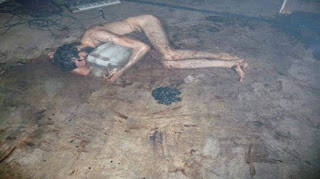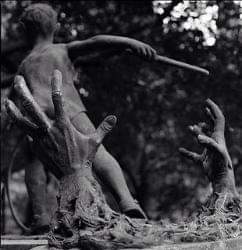29 Jun, 1941 - Germany invaded and occupied Lvov, in eastern Galicia, in the Ukraine. Thousands of people were slaughtered.
At the start of World War II, Lvov changed hands, this time falling under the control of the Soviets, who entered the city on September 22, 1939 and immediately annexed it together with the rest of Eastern Galicia. Refugees poured into the city from German-occupied western Poland, and the Jewish population ballooned to more than 200,000. In the summer of 1940, many of them were expelled to the remote regions of the Soviet Union.
Under the Soviets, Lvov underwent a process of “Ukrainization,” whereby Jewish shopkeepers were forced to sell their stocks, and later liquidate their businesses, and synagogues were forced to close down. Schools were instructed to adopt Soviet curriculums, and the Ukrainian language was gradually introduced at the expense of Yiddish. However, about 100,000 Jewish refugees from western Poland gathered in Lvov during this time, which led to widespread Yiddish cultural activity.
Following the German invasion of the Soviet Union on June 22, 1941, about 10,000 managed to escape from Lvov, together with the retreating Red Army. Germany captured the city on June 30, 1941, and the systematic decimation of the Jewish community began that same day, with nearly 4,000 murdered instantly in pogroms carried out over a four day period by members of the Einsatzgruppe C, German soldiers, Ukrainian nationalists, and the local population, fueled by rumors that Jews had participated in the execution of Ukrainian political prisoners, whose bodies had been discovered in the dungeons of the NKVD (the Soviet political police). The riots finally subsided on July 3, 1941.
On July 8, Jews over the age of fourteen were required to wear a white badge with a blue Star of David on their arms at all times. July 25 to 27 again witnessed mass riots, which left 2,000 more Jews dead. These pogroms became to be known as the Petliura Days.
A temporary Jewish committee was established at the end of July 1941, which comprised of five prominent community leaders. The committee was enlarged in a relatively short time and became a Judenrat (a Jewish council), with Dr. Joseph Parnes serving as the chairman.
The summer of 1941 was a terrible time for the Jews of Lvov – synagogues were destroyed, property was stolen and cemeteries were desecrated. Thousands were sent to off to be used as forced labor in the building of bridges, roads and military training camps for the Germans.
In September, a Jewish police force was set up under the Judenrat, to keep order and ensure cleanliness in the streets where Jews resided, to confiscate valuables at the request of the Germans, and to escort people on their way to forced labor. Parnes, the leader of the Judenrat, was killed by the Nazis at the end of October for refusing to hand over Jews who were then going to be moved to the Janówska work camp. Abraham Rotfeld replaced him.
On November 8, the Nazis published an order on the establishment of the Jewish ghetto of Lvov, which would eventually hold more than 100,000 people. They had until December 15 to pack up their belongings and move into the ghetto. During this time, as Jews began to file into the ghetto, five thousand elderly and sick Jews were killed as they were about to cross the bridge on Peltewna Street.
The deportations began soon after, during the winter of 1941-1942 with the Nazis sending thousands at a time to the labor camps at Laszki Murowane, Hermanów, Vinniki, Jaktorów, Kamionka Strumilowa, and Skole. In February 1942, Abraham Rotfeld died, leaving Henryk Landsberg in charge as Judenrat chairman, at the appointment of the Germans.
In March 1942, the Judenrat was forced to hand over lists of Jews who could be sent to work in camps in the East. A delegation of rabbis pleaded with Landsberg and begged him not to cooperate, but Landesberg refused, stating that many more would be killed if refused to hand over the lists. This Aktion began on March 19, and continued until the end of the month. Nearly 15,000 Jews were deported to the Belzec extermination camp, 60 miles to the north in Poland. On July 8, many were also sent to the Janówska labor camp in the northern outskirts of Lvov where most were shot to death by firing squads. On August 10, another mass deportation ensued, which lasted until August 23, and 50,000 Jews were again sent to the Belzec death camp.
In September, the ghetto was sealed, and the Nazis hanged Landsberg and a group of Judenrat members. Eduard Eberson then became head of the Judenrat in Lvov. Toward the end of 1942, the ghetto having been greatly reduced by further deportations, it became to act as more of a labor camp. The ghetto officially became a labor camp in January 1943, called a Julag (Judenlager, or “Jewish camp”). Ten thousand Jews were executed immediately, being that they could not produce a proper employment card. The Judenrat was disbanded on January 30, and most of the remaining members were killed. An Oberjude (chief Jew) was then appointed to serve as a liaison between the ghetto and the Nazis.
By May 1943, another 1,500 Jews had been murdered inside the ghetto and 800 were transported to Auschwitz. The Selektionen process was then speeded up, and only those deemed “vitally important” were permitted to stay. The rest were killed.
The ghetto was liquidated in June 1, 1943. Every avenue of escape was sealed off, and additional police units were called into assist. A small number of Jews managed to launch a few hand grenades and Molotov cocktails and the encroaching German and Ukrainian police forces. They managed to kill nine and wound twenty before the Germans began to set the buildings on fire. During the liquidation, 7,000 Jews were seized and sent to Janówska, where they were immediately murdered, and three thousand were killed in the ghetto itself. It was all over in a day. By the time the Soviets reentered the city in July 1944, only a handful of Jews remained.










Comments
Post a Comment